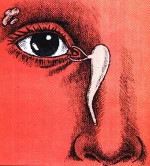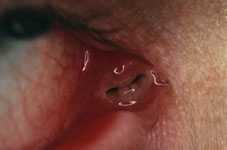The Wet Eye
The Wet Eye - "Excessive Tearing"
Dr. Ebroon's Other Services
The Wet Eye - "Excessive Tearing"
In order for the eye to remain healthy, it must remain moist. The lacrimal gland is a specialized gland located under the outer one-third of the upper eyelid that makes tears. Each time you blink, the eyelid spreads the tears over the surface of the eye and pumps excess tears into a "duct" that drains the tears into your nose. That is why your nose runs when you cry.
Diagram of tear gland and tear duct:
Dry Eyes If the lacrimal gland fails to produce enough tears to properly wet the eye, the surface of the eye begins to dry out. An eye that is too dry typically burns, stings and feels as if there is sand in it. Artificial tears and lubricating ointments will help control the drying and irritation that occurs when too few tears are produced. However, when adding lubricants to the eye does not adequately relieve the discomfort, closing the openings of the tear drainage system that drains tears from the eye into the nose can help. The closure can be performed temporarily with the insertion of silicone or collagen plugs, or it can be performed more permanently with surgery. In extreme cases, other eyelid procedures may be required to control the drying.
Wet Eyes If the lacrimal gland is producing tears properly and the "duct" that drains the tears from the eye into the nose becomes non-functioning, the tears will back up and spill over the eyelid and cause tears to run down the face. If one has a plugged up "tear duct," not only will tears spill over the eyelids and run down the face, but the stagnant tears within the system can become infected.
Diagram of "blocked" tear duct:
An infection within the "tear duct" causes a painful swelling in the inner corner of the eyelids. If the tearing causes severe symptoms, surgery can be performed to create a new tear duct. This operation is called "dacryocystorhinostomy." Dr. Ebroon may place small silicone tubes temporarily to keep the new tear duct open while healing occurs. Surgical elimination of the obstruction by creating a new tear duct is necessary to eliminate the tearing and infection that can result from such a blockage.
Patient with infected tear duct:
Children are frequently born with an obstruction within the "tear duct." When this occurs, tearing results. The stagnant tears within the "tear duct" often become infected causing pus (heavy matter) to collect between the eyelids. Such obstructions may dissolve on their own within the first few months of life. If not, the ophthalmic reconstructive surgeon can eliminate this problem with surgical techniques.
Occasionally, the "tear duct" obstruction will be beyond repair. When this happens, it is necessary to surgically implant an artificial "tear duct" behind the inner corner of the eyelids to drain the tears into the nose. The artificial "tear duct" is made of Pyrex glass and is called a "Jones tube."
A patient with a Jones tube:
Patients with problems of the tear drainage system are most commonly treated by ophthalmic plastic and reconstructive surgeons who specialize in diseases and conditions affecting the eyelids, the lacrimal system, the orbit, and adjacent facial structures. Fellowship in the American Society of Ophthalmic Plastic and Reconstructive Surgery (ASOPRS) indicates that the surgeon has special training and expertise in this subspecialty and that he or she is board certified by the American Board of Ophthalmology or its equivalent.






